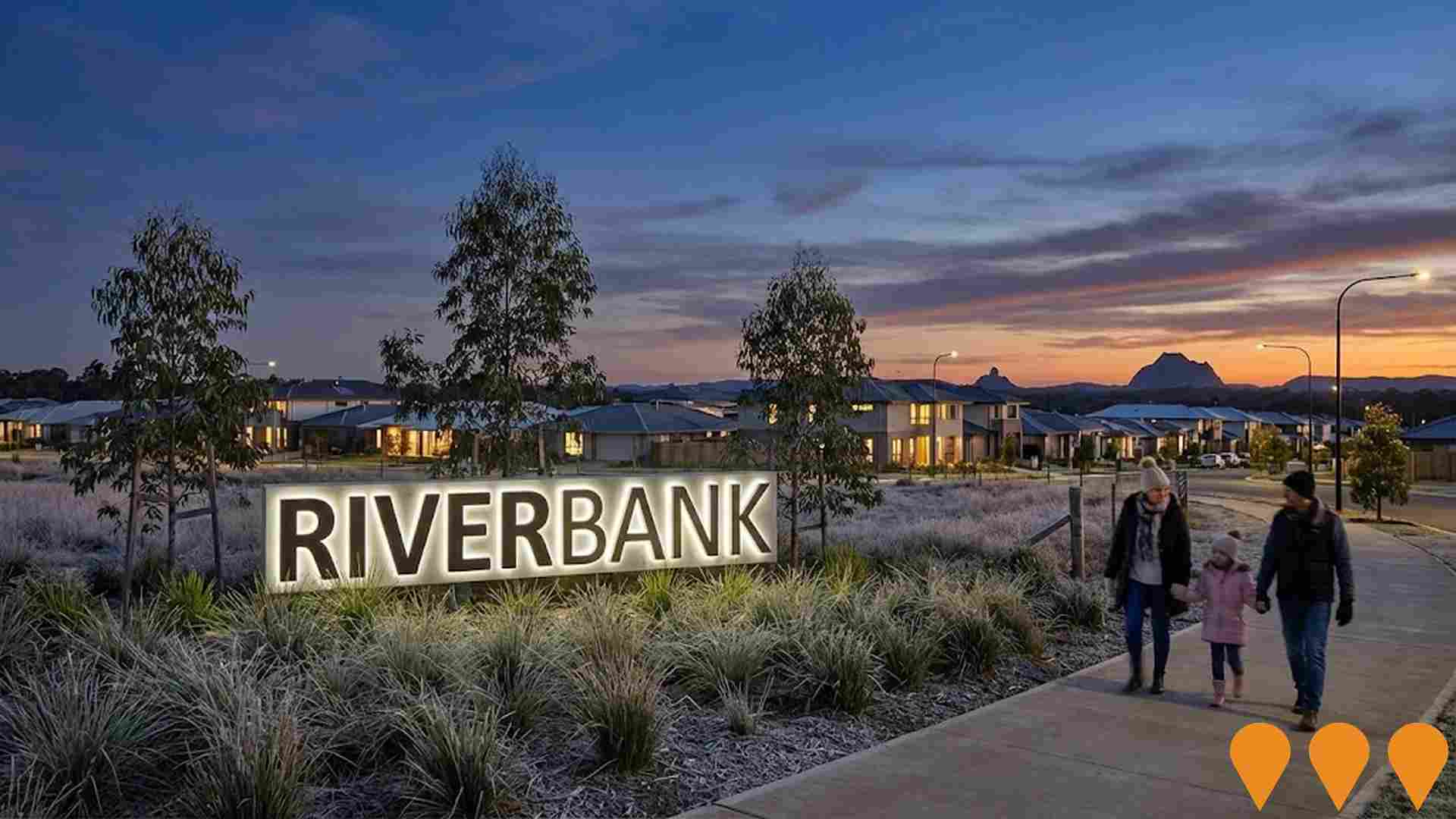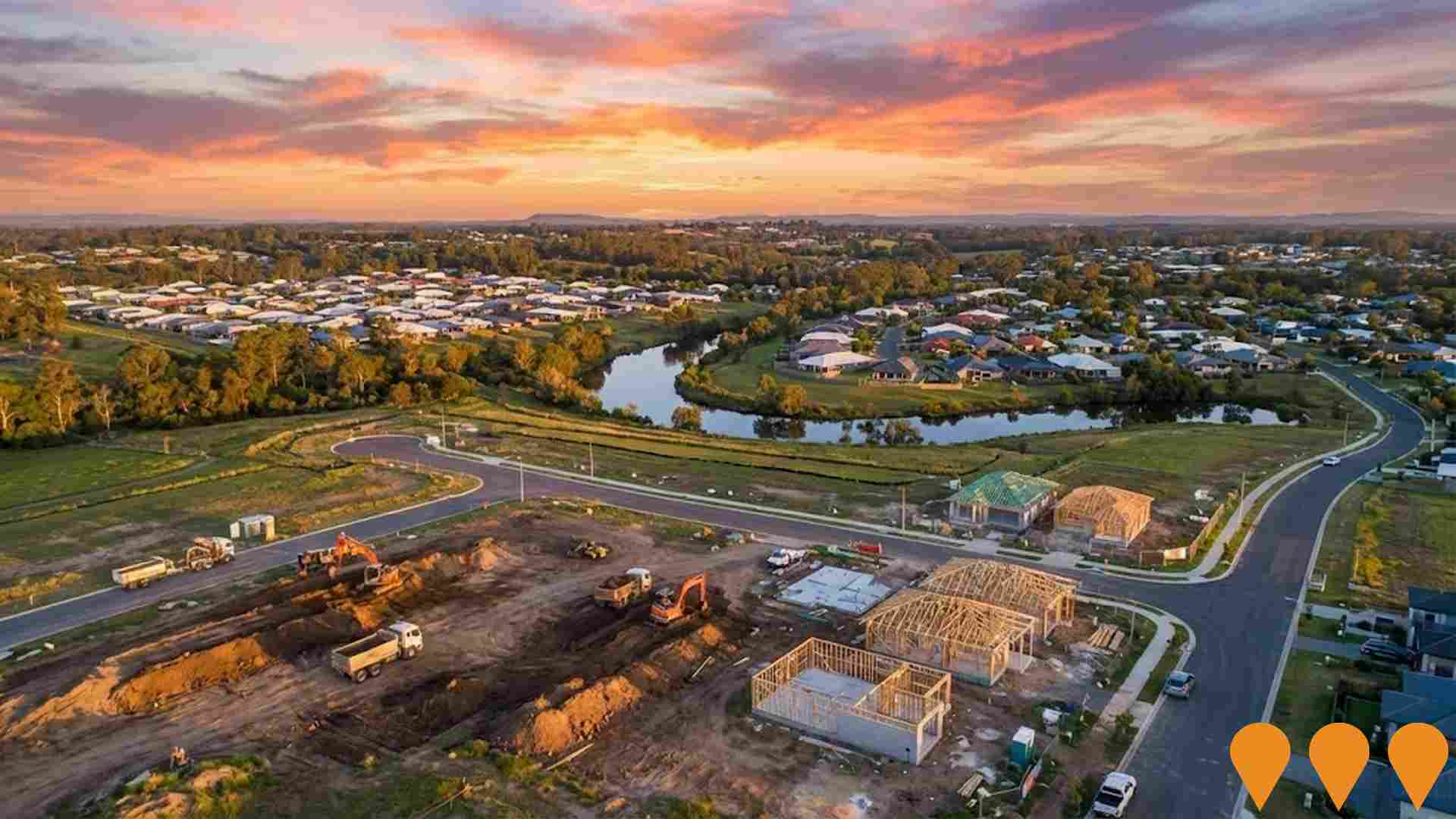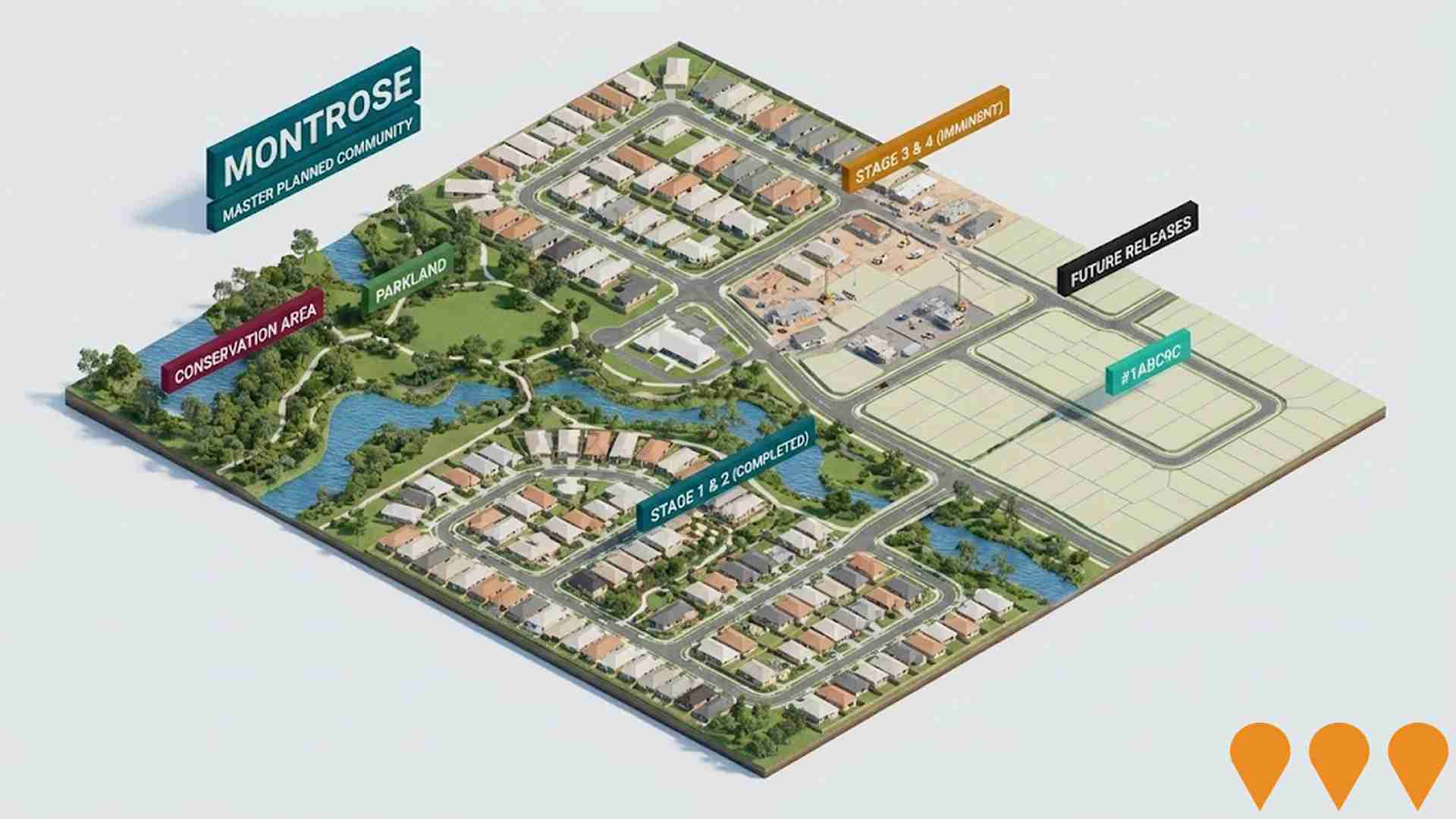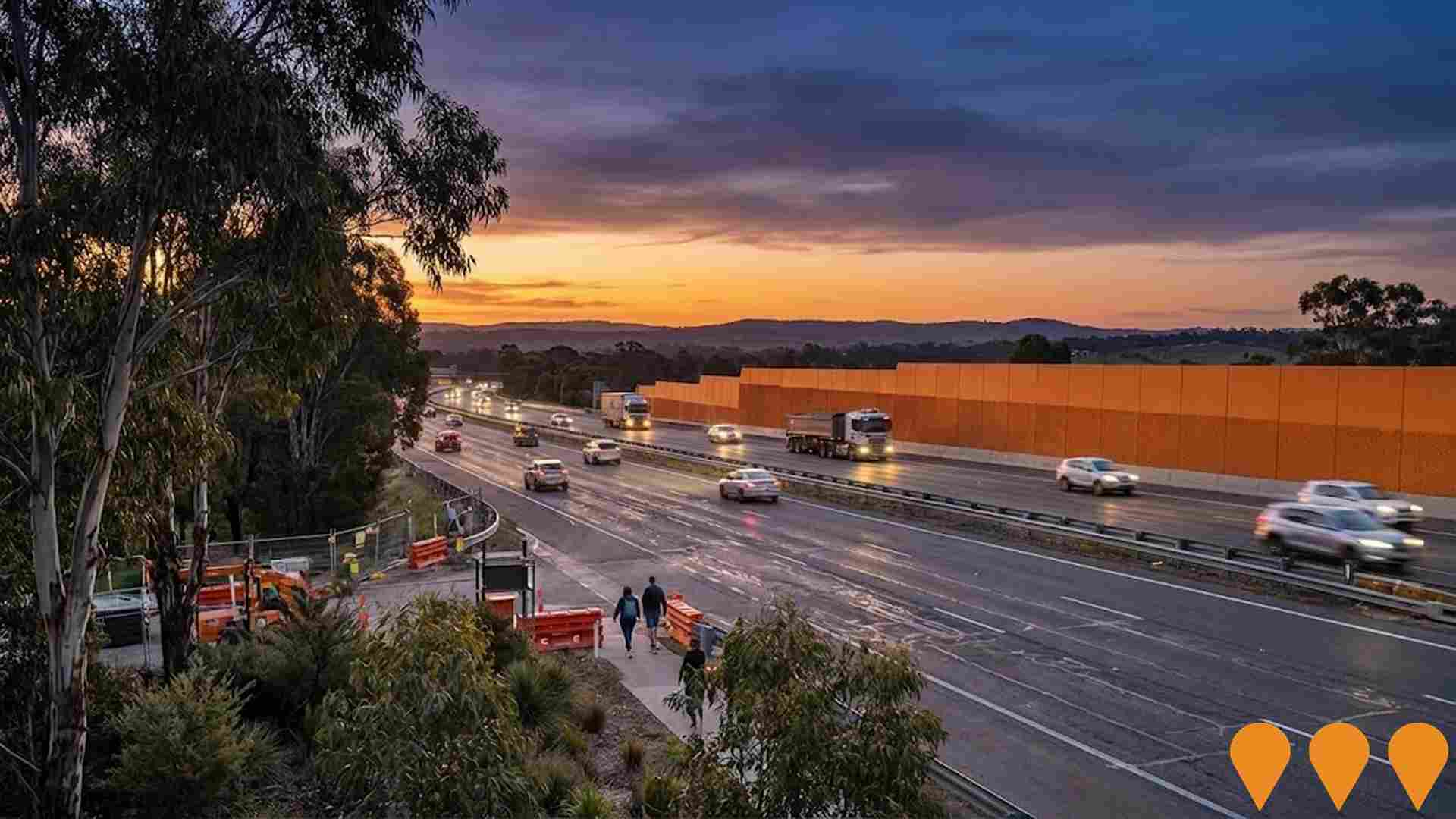Chart Color Schemes
est. as @ -- *
ABS ERP | -- people | --
2021 Census | -- people
Sales Activity
Curious about local property values? Filter the chart to assess the volume and appreciation (including resales) trends and regional comparisons, or scroll to the map below view this information at an individual property level.
Find a Recent Sale
Sales Detail
Population
Caboolture - South lies within the top quartile of areas nationally for population growth performance according to AreaSearch analysis of recent, and medium to long-term trends
Caboolture - South's population was around 28,297 as of August 2025, according to AreaSearch's analysis. This figure reflects a growth of 4,672 people since the 2021 Census, which reported a population of 23,625. The increase is inferred from ABS data showing an estimated resident population of 27,015 in June 2024 and an additional 847 validated new addresses since the Census date. This results in a population density ratio of 2,024 persons per square kilometer, higher than the average seen across national locations assessed by AreaSearch. The area's growth rate of 19.8% since the 2021 census exceeded both the national average (8.6%) and the state average, making it a growth leader in the region. Interstate migration contributed approximately 60.8% of overall population gains during recent periods, with all drivers including overseas migration and natural growth being positive factors.
AreaSearch uses ABS/Geoscience Australia projections for each SA2 area, released in 2024 using 2022 as the base year. For areas not covered by this data and years post-2032, Queensland State Government's SA2 area projections are adopted, released in 2023 based on 2021 data. However, these state projections do not provide age category splits, so AreaSearch applies proportional growth weightings in line with ABS Greater Capital Region projections for each age cohort, released in 2023 using 2022 data as the base year. Based on projected demographic shifts, Caboolture - South is expected to increase by 9,906 persons to 2041, recording a total gain of 30.5% over the 17 years.
Frequently Asked Questions - Population
Development
The level of residential development activity in Caboolture - South was found to be higher than 90% of real estate markets across the country
Caboolture - South has seen approximately 337 new homes approved annually. Between FY-21 and FY-25, around 1,688 homes were approved, with an additional 74 approved in FY-26 as of current data. Over these five financial years, an average of 2.4 people moved to the area per new home constructed, indicating strong demand that supports property values.
The average construction cost value for new homes was $340,000, which is below the regional average, suggesting more affordable housing options for buyers. This year has seen $28.0 million in commercial approvals registered, reflecting robust commercial development activity. Compared to Greater Brisbane, Caboolture - South maintains similar construction rates per capita, indicating a balanced market consistent with the broader area. However, recent periods have shown some moderation in development activity.
Nationally, development activity levels are substantially higher, suggesting strong developer confidence in the location. New development consists of 75% detached dwellings and 25% attached dwellings, preserving the area's traditional suburban character focused on family homes. With around 112 people per approval, Caboolture - South reflects a developing area. By 2041, it is projected to grow by approximately 8,624 residents. Based on current development patterns, new housing supply should readily meet demand, offering favorable conditions for buyers and potentially facilitating population growth beyond current projections.
Frequently Asked Questions - Development
Infrastructure
Caboolture - South has moderate levels of nearby infrastructure activity, ranking in the top 50% nationally
Changes to local infrastructure significantly influence an area's performance. AreaSearch has identified 52 projects likely to impact the area. Notable projects include Coles Caboolture West, Morayfield Marketplace, Arbourwood Residential Community, and Bright Community. The following list details those most relevant.
Professional plan users can use the search below to filter and access additional projects.
INFRASTRUCTURE SEARCH
 Denotes AI-based impression for illustrative purposes only, not to be taken as definitive under any circumstances. Please follow links and conduct other investigations from the project's source for actual imagery. Developers and project owners wishing us to use original imagery please Contact Us and we will do so.
Denotes AI-based impression for illustrative purposes only, not to be taken as definitive under any circumstances. Please follow links and conduct other investigations from the project's source for actual imagery. Developers and project owners wishing us to use original imagery please Contact Us and we will do so.
Frequently Asked Questions - Infrastructure
Coles Caboolture West
New neighbourhood shopping centre anchored by a full-line 3,600sqm Coles supermarket, Coles Liquorland, approximately 8 specialty tenancies, medical centre, and associated car parking (approximately 290 spaces) and landscaping.
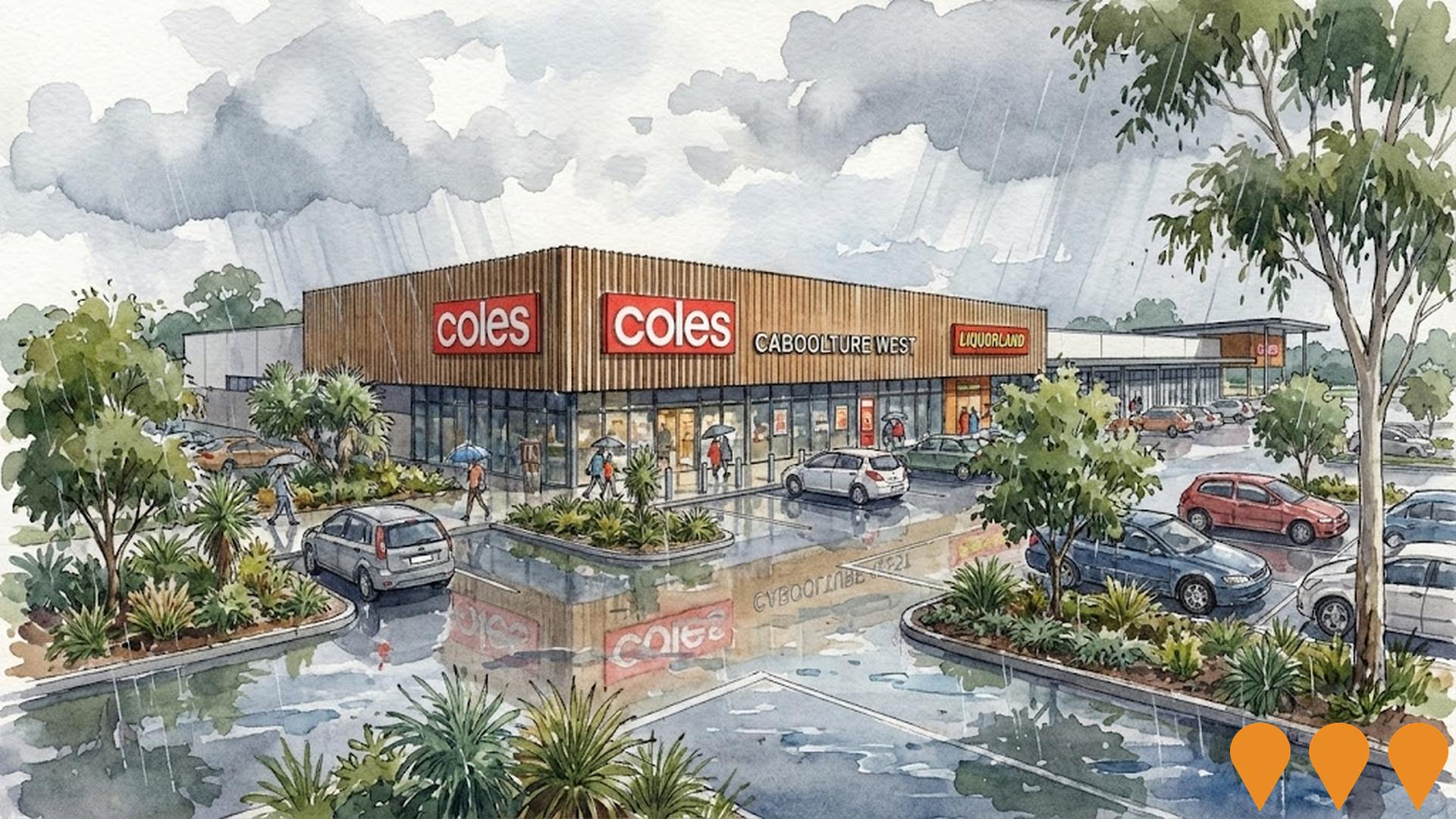
Morayfield Marketplace
A $48 million neighbourhood shopping centre development by JAM Group and RankinCorp. Features a full-line Coles supermarket, medical centre, childcare centre, gym, specialty retail, food and beverage tenancies, service station and over 390 car parks. The centre is being delivered in stages with the childcare facility under construction in 2025 and the main centre works commencing mid-2025. Expected completion late 2026, creating approximately 225 ongoing jobs.

Summerstone Estate
Summerstone is a master-planned residential community in Morayfield, approximately 45 km north of Brisbane CBD. The 450-lot estate features parks, reserves, playgrounds, a frisbee golf course, pump track, riding trails, and extensive landscaping. Construction is well underway with multiple stages actively progressing toward completion by 2027.

Buchanan Road and William Berry Drive Upgrade
A major $200 million transport infrastructure upgrade to widen Buchanan Road and William Berry Drive between Morayfield Road and the Bruce Highway. The project includes four-laning both roads, constructing a new bridge over the Caboolture railway line and Sheepstation Creek, upgrading the Graham Road intersection to traffic signals, and improving flood immunity. The upgrade will accommodate projected regional growth, provide better Bruce Highway connectivity, and include new pedestrian and cyclist pathways. The corridor currently carries 19,500 vehicles daily and is planned to handle 32,000 vehicles by 2036.

Caboolture River Road Upgrade
The Caboolture River Road upgrade involves transforming a four-kilometer section from Morayfield Road to west of Crome Court into an enhanced four-lane carriageway to meet growing community needs, supporting regional growth and improving traffic flow in response to population growth in the City of Moreton Bay. The upgrades are planned to accommodate future demands and benefit existing and new communities, including the development at Waraba (Caboolture West). The project is divided into three sub-projects, each with specific funding and delivery arrangements.

150-Place Childcare Centre and Swim School
A 150-place childcare centre and swim school developed by ADPEN as part of the Morayfield Marketplace project, which also includes 80 residential lots. The facility aims to support family services in the growing Morayfield area. Construction is ongoing as of July 2025, with an estimated value of $13 million, expected to create 400 construction jobs and 60 permanent jobs.

Waraba Primary School
A new state primary school in the Waraba development (formerly Caboolture West), planned to open between 2028 and 2030 to accommodate growing student enrolments. The school will cater for Prep to Year 6 and is part of the educational infrastructure supporting the new community.

Morayfield Shopping Centre Expansion
Major expansion of the existing Morayfield Shopping Centre, adding 15,000 sqm of retail space, new department stores, specialty shops, dining precinct, and improved parking facilities. Will create approximately 800 jobs during construction and 400 permanent retail positions.
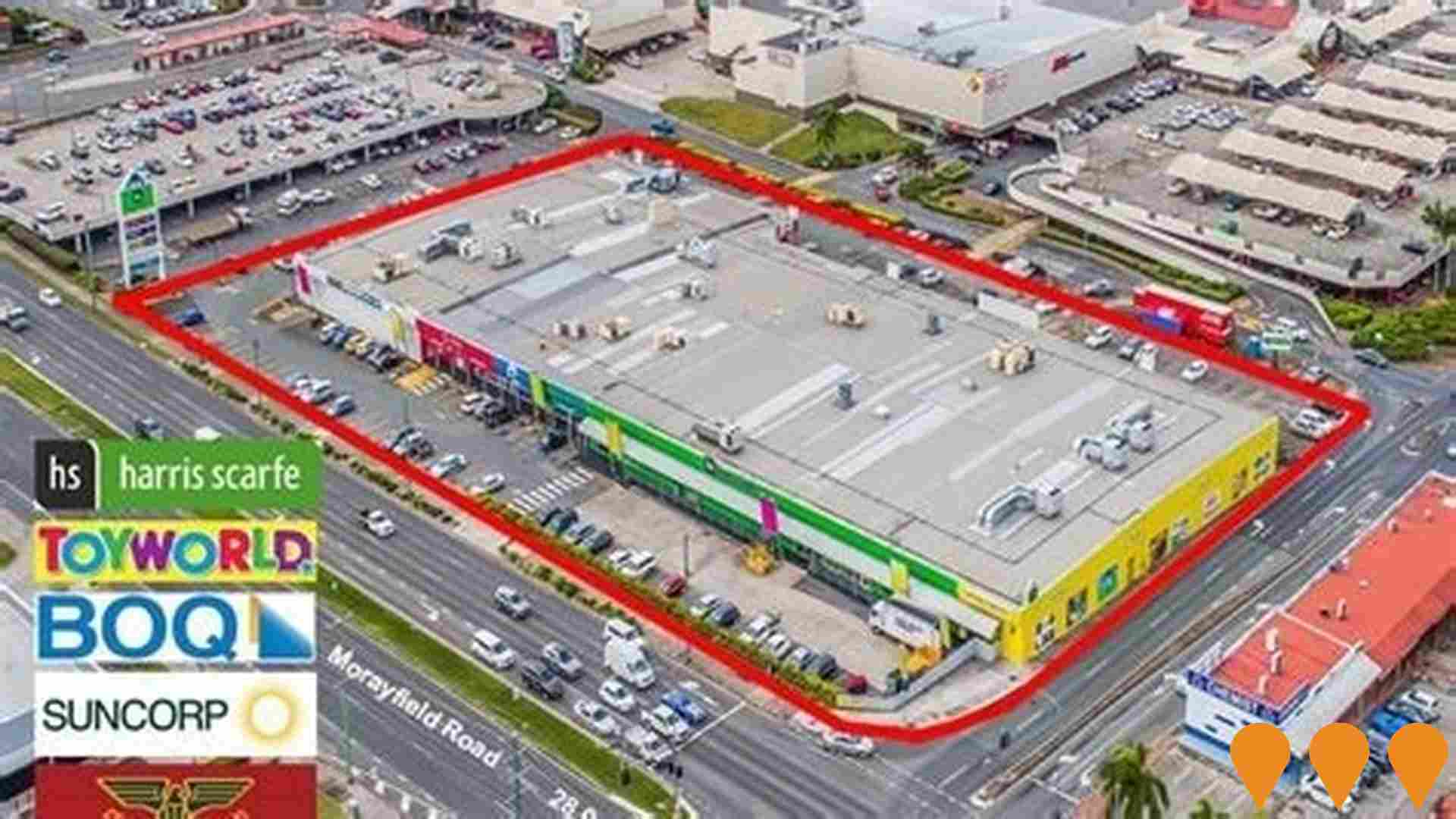
Employment
Caboolture - South shows employment indicators that trail behind approximately 70% of regions assessed across Australia
Caboolture - South has a balanced workforce with white and blue collar jobs, diverse sector representation, and an unemployment rate of 6.4%. In the year ending June 2025, employment grew by 12.8%.
There are 11,592 residents in work, with an unemployment rate of 7.3%, which is 3.2 percentage points higher than Greater Brisbane's rate of 4.1%. Workforce participation is lower at 54.6% compared to Greater Brisbane's 64.5%. Key employment sectors are health care & social assistance, retail trade, and construction. Retail trade is particularly strong with an employment share 1.4 times the regional level.
However, professional & technical services are under-represented at 3.3%, compared to 8.9% in Greater Brisbane. The area offers limited local employment opportunities, as indicated by Census data. Over the year ending June 2025, employment increased by 12.8% and labour force grew by 8.3%, leading to a 3.8 percentage point drop in unemployment. In comparison, Greater Brisbane recorded employment growth of 4.4%. National employment forecasts from Jobs and Skills Australia, released May 2025, project national employment growth of 6.6% over five years and 13.7% over ten years. Applying these projections to Caboolture - South's employment mix suggests local growth of approximately 6.1% over five years and 13.0% over ten years.
Frequently Asked Questions - Employment
Income
Income figures position the area below 75% of locations analysed nationally by AreaSearch
AreaSearch's latest postcode level ATO data for financial year ending June 2022 indicates that median income in Caboolture - South is $47,163, with average income at $53,434. This is lower than national averages. In Greater Brisbane, median income was $55,645 and average income was $70,520 during the same period. Based on a 13.99% increase in wages since June 2022, estimated median income for Caboolture - South as of September 2025 would be approximately $53,761, and average income would be around $60,909. According to the 2021 Census, incomes in Caboolture - South fall between the 17th and 19th percentiles nationally for households, families, and individuals. The earnings profile shows that 32.2% of locals (9,111 people) earn between $1,500 and $2,999 annually, reflecting a pattern seen across the region where 33.3% fall within this income range. Housing affordability pressures are severe in Caboolture - South, with only 79.4% of income remaining after housing costs, ranking at the 15th percentile nationally.
Frequently Asked Questions - Income
Housing
Caboolture - South is characterized by a predominantly suburban housing profile, with a higher proportion of rental properties than the broader region
Caboolture - South's dwelling structure, as per the latest Census, comprised 82.8% houses and 17.3% other dwellings. In Brisbane metro, this was 83.4% houses and 16.5% other dwellings. Home ownership in Caboolture - South was 22.7%, similar to Brisbane metro's 22.9%. Mortgaged dwellings were 29.5% and rented ones 47.8%. The median monthly mortgage repayment was $1,473, lower than Brisbane metro's $1,625. Median weekly rent was $340, compared to Brisbane metro's $335. Nationally, Caboolture - South's mortgage repayments were significantly lower than the Australian average of $1,863, while rents were less than the national figure of $375.
Frequently Asked Questions - Housing
Household Composition
Caboolture - South features high concentrations of group households, with a fairly typical median household size
Family households constitute 72.0% of all households, including 26.0% couples with children, 23.9% couples without children, and 20.6% single parent families. Non-family households comprise the remaining 28.0%, with lone person households at 23.5% and group households making up 4.5%. The median household size is 2.7 people, which aligns with the Greater Brisbane average.
Frequently Asked Questions - Households
Local Schools & Education
Caboolture - South faces educational challenges, with performance metrics placing it in the bottom quartile of areas assessed nationally
The area faces educational challenges, with university qualification rates at 10.6%, significantly below the Greater Brisbane average of 30.5%. This presents both a challenge and an opportunity for targeted educational initiatives. Bachelor degrees are most common at 8.0%, followed by graduate diplomas (1.4%) and postgraduate qualifications (1.2%). Trade and technical skills are prominent, with 44.1% of residents aged 15+ holding vocational credentials – advanced diplomas at 10.3% and certificates at 33.8%.
Educational participation is high, with 31.2% of residents currently enrolled in formal education. This includes 12.8% in primary education, 8.9% in secondary education, and 2.9% pursuing tertiary education. Caboolture - South's 5 schools have a combined enrollment reaching 1,987 students while the area demonstrates varied educational conditions across Caboolture - South. Education provision is balanced with 4 primary and 1 secondary school serving distinct age groups. Limited local school capacity (7.0 places per 100 residents vs 16.2 regionally) means many families travel to nearby areas for schooling. Note: where schools show 'n/a' for enrolments, please refer to the parent campus.
Frequently Asked Questions - Education
Schools Detail
Nearby Services & Amenities
Transport
Transport servicing is moderate compared to other areas nationally based on assessment of service frequency, route connectivity and accessibility
Caboolture - South has 74 active public transport stops operating. These are a mix of train and bus stops serviced by 59 individual routes. Together, these routes provide 2,868 weekly passenger trips.
Transport accessibility is rated as good, with residents typically located 352 meters from the nearest stop. Service frequency averages 409 trips per day across all routes, equating to approximately 38 weekly trips per stop.
Frequently Asked Questions - Transport
Transport Stops Detail
Health
Health performance in Caboolture - South is well below average with a range of health conditions having marked impacts on both younger and older age cohorts
Caboolture - South faces significant health challenges, with various conditions impacting both younger and older residents. Private health cover is low at approximately 47% of the total population (~13,299 people), compared to the national average of 55.3%.
Mental health issues and asthma are the most common medical conditions in the area, affecting 12.1 and 9.7% of residents respectively. However, 60.2% of residents report having no medical ailments, slightly lower than the 61.9% across Greater Brisbane. The area has a higher proportion of seniors aged 65 and over at 18.2%, with 5,164 people falling into this age group compared to 17.0% in Greater Brisbane. Health outcomes among seniors present challenges broadly in line with the general population's health profile.
Frequently Asked Questions - Health
Cultural Diversity
Caboolture - South ranks below the Australian average when compared to other local markets across a number of language and cultural background related metrics
Caboolture-South, when assessed for cultural diversity, showed lower than average figures. Its population composition was predominantly Australian citizens, with 84.7%, born in Australia, at 81.2%, and speaking English at home exclusively, at 92.4%. Christianity emerged as the dominant religion, accounting for 41.7% of Caboolture-South's inhabitants.
Notably, the 'Other' religious category comprised 0.9% of the population, slightly higher than the 0.8% recorded across Greater Brisbane. In terms of ancestry, the top three groups were English at 30.6%, Australian at 29.4%, and Irish at 6.8%. Some ethnic groups showed significant variations: Maori was overrepresented at 1.4% compared to the regional average of 1.2%, New Zealanders at 1.2% versus 1.1%, and Samoans at 1.0% against a regional figure of 0.7%.
Frequently Asked Questions - Diversity
Age
Caboolture - South's young demographic places it in the bottom 15% of areas nationwide
Caboolture - South's median age is 33 years, which is slightly younger than Greater Brisbane's average of 36 years and significantly lower than Australia's national average of 38 years. Compared to Greater Brisbane, Caboolture - South has a higher proportion of residents aged 5-14 (14.8%) but fewer residents aged 35-44 (12.0%). According to post-2021 Census data, the population aged 75 to 84 has increased from 5.3% to 7.1%. Conversely, the proportion of residents aged 5 to 14 has declined from 15.8% to 14.8%. Demographic projections suggest significant changes in Caboolture - South's age profile by 2041. The 75 to 84 cohort is projected to grow by 105%, adding 2,106 residents to reach a total of 4,118 residents. Residents aged 65 and older are expected to represent 51% of the population growth. Meanwhile, the 25 to 34 age group is projected to grow by a modest 2%, with an increase of 70 people.
